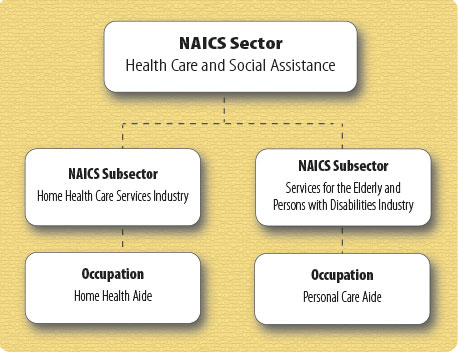
by Chloe Campbell
March 2017
Demand for home-based services that support older adults and people with disabilities is growing with the increasing needs of an aging population.
Services that enable elderly and people with disabilities to receive care and support while living independently are becoming increasingly important as the population ages.
This article spotlights two sectors that provide those services – the home health care services industry and the services for the elderly and persons with disabilities industry.

The home health care services industry provides skilled nursing care in the home, primarily employing home health aides. Services include personal care, homemaker and companion services, physical therapy, medical social services, medications, medical equipment and supplies, counseling, 24-hour home care, occupation and vocational therapy, diet and nutrition, speech therapy, and high-tech care such as intravenous therapy.
The services for the elderly and persons with disabilities industry provides nonresidential social assistance services to improve quality of life for the elderly, people diagnosed with intellectual and developmental disabilities, or people with physical disabilities. Personal care aides and others provide day care, nonmedical home care or homemaker services, social activities, group support, companionship and other services.
The need for these two industries is not new. Nearly 150 years ago members of the Good Cheer Society of Nashua, N.H., grew concerned about the health and wellness of the city's underprivileged citizens. Initially members visited homes of the poor and brought "jam, jelly and flowers to spread some cheer, but soon found a much greater need – families that were cold and children that were sick."1
Determined to help in a meaningful way, members donated fuel and clothing and helped mothers take care of their sick children. In 1902, the Society hired its first nurse and several years later hired a supervisor and additional nurses to make home visits. By 1936 the Society had raised enough money to purchase a building to provide nursing and child welfare services. For many years the Society met the health needs of the community's poorest residents and provided the only bedside nursing care available outside the family.
By 1963, more than 1,100 home health care agencies were operating in the United States. The industry received a dramatic boost in 1965 when President Lyndon Johnson signed Medicare and Medicaid into law as an amendment to the Social Security Act. Medicare made home care services available to Americans 65 and older.
In 1972 these benefits were extended to Americans under 65 with certain disabilities and Americans of all ages with permanent kidney disease. Medicaid initially provided insurance to Americans receiving cash assistance from the government and has since grown to cover low-income families, pregnant women, people of all ages with disabilities and people who need long-term care.
A landmark ruling by the U.S. Supreme Court in 1999 in Olmstead v. L.C. deemed the segregation of people with disabilities to violate Title II of the Americans with Disabilities Act. The court held that public entities must provide community-based services to people with disabilities within certain limitations.2 The ruling prompted states, including Minnesota, to ensure that their policies complied with the law and led to increased demand for home-based health care services.
More recently, the aging population has increased demand for home-based care services. The oldest baby boomers turned 70 in 2016. So while demand for home health care services has been strong, growth is expected to surge over the next decade and beyond.
Quarterly Census of Employment and Wages (QCEW) data show the number of establishments in the industry more than tripled between 2000 and 2015, while employment grew by 154.9 percent with the addition of 14,460 jobs over that period (see Table 1).
| Home Health Care Services | ||
|---|---|---|
| Year | Establishments | Employment |
| 2015 | 471 | 23,795 |
| 2014 | 485 | 23,300 |
| 2013 | 458 | 21,434 |
| 2012 | 437 | 19,764 |
| 2011 | 432 | 19,026 |
| 2010 | 416 | 19,054 |
| 2009 | 394 | 18,095 |
| 2008 | 370 | 15,999 |
| 2007 | 316 | 14,375 |
| 2006 | 281 | 13,290 |
| 2005 | 240 | 12,555 |
| 2004 | 202 | 11,475 |
| 2003 | 181 | 10,754 |
| 2002 | 159 | 9,849 |
| 2001 | 146 | 9,194 |
| 2000 | 145 | 9,335 |
| Source: Quarterly Census of Employment and Wages | ||
The services for the elderly and persons with disabilities industry has also grown in conjunction with policies that encourage independent living in the aging population. Over the same 15-year period, 2000 to 2015, the number of establishments in this industry grew by 153.1 percent, while employment increased by 369.8 percent with the addition of 31,016 jobs (see Table 2).
| Services for the Elderly and
Persons with Disabilities |
||
|---|---|---|
| Year | Establishments | Employment |
| 2015 | 919 | 39,403 |
| 2014 | 884 | 36,727 |
| 2013 | 830 | 32,425 |
| 2012 | 859 | 30,536 |
| 2011 | 838 | 30,277 |
| 2010 | 729 | 29,008 |
| 2009 | 697 | 28,481 |
| 2008 | 637 | 26,144 |
| 2007 | 600 | 23,507 |
| 2006 | 615 | 22,125 |
| 2005 | 598 | 19,496 |
| 2004 | 543 | 17,072 |
| 2003 | 498 | 14,051 |
| 2002 | 421 | 11,114 |
| 2001 | 382 | 9,432 |
| 2000 | 363 | 8,387 |
| Source: Quarterly Census of Employment and Wages | ||
The Minnesota State Demographic Center projects that one in five Minnesotans will be 65 or older by 2030, and they will outnumber the 18 and under population by 2035.
In January 2015, about 38,500 Minnesotan were enrolled in the state's Medical Assistance Elderly Waiver program, which provides long-term care services for older adults. Based on population projections, enrollment in the program will grow to 59,300 people in 2030 and 71,500 in 2040.3
In less than 20 years, Minnesota's older adult population will be approaching 1.26 million. Enrollment in the state Medical Assistance program (Minnesota's version of Medicaid) is projected to increase 85 percent to 71,500. There is no doubt that the home health care services industry will experience tremendous growth and challenges as it expands to meet the public need.
The December 2016 issue of Minnesota Employment Trends profiled two occupations in these industries: home health aides and personal care aides. While there is strong demand and growth in both occupations, low wages and a tight labor market are making the positions difficult to fill. The question for policymakers is how to address current and future challenges facing the industry.
2Olmstead: Community Integration for Everyone
3Demographic Considerations for Long-Range & Strategic Planning